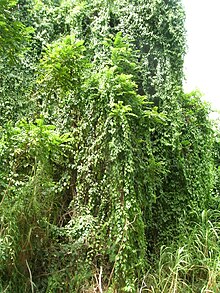Cissus verticillata
| Cissus verticillata | |
|---|---|

| |
| Scientific classification | |
| Kingdom: | Plantae |
| Clade: | Tracheophytes |
| Clade: | Angiosperms |
| Clade: | Eudicots |
| Clade: | Rosids |
| Order: | Vitales |
| Family: | Vitaceae |
| Genus: | Cissus |
| Species: | C. verticillata
|
| Binomial name | |
| Cissus verticillata (L.) Nicolson & C.E.Jarvis
| |
| Synonyms | |
|
Cissus sicyoides L. | |
Cissus verticillata, the princess vine[1] or seasonvine,[2] is an evergreen perennial vine in the grapevine family Vitaceae.
Folk medicine
Historical folk medicine recommendations include "weakness of the stomach", fevers and antiepileptic action. The root bark was also chewed "to strengthen teeth".[3]
History and naming
Cissus verticillata (= C. sicyoides) was discovered in 1571 in Mexico (probably in what is today the state of Michoacán) and first described in 1574 by Nicolás Monardes who named in Spanish Carlo Sancto. In Europe the plant was compared to hop (Humulus lupulus L.) so it was named by Caspar Bauhin Lupulus Mechiocanus (which means "hop of Michoacán"). The roots of Cissus verticillata were exported to Europe as a medicinal stock. The last certain reports that this medicinal stock was present in European market originate from the decline of the 18th century[3]
References
- ^ "Cissus verticillata". Germplasm Resources Information Network. Agricultural Research Service, United States Department of Agriculture. Retrieved 10 September 2020.
- ^ USDA, NRCS (n.d.). "Cissus verticillata". The PLANTS Database (plants.usda.gov). Greensboro, North Carolina: National Plant Data Team. Retrieved 10 September 2020.
- ^ a b Drobnik, J.; de Oliveira, A. B. (2015). "Cissus verticillata (L.) Nicolson & C.E. Jarvis (Vitaceae): its identification and usage in the sources from 16th to 19th century". Journal of Ethnopharmacology. 171: 317–329. doi:10.1016/j.jep.2015.06.003. PMID 26074377.

